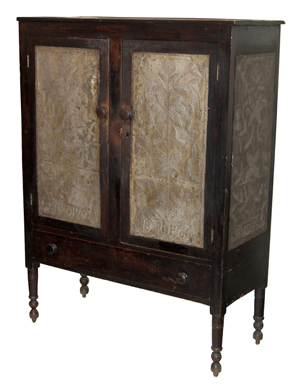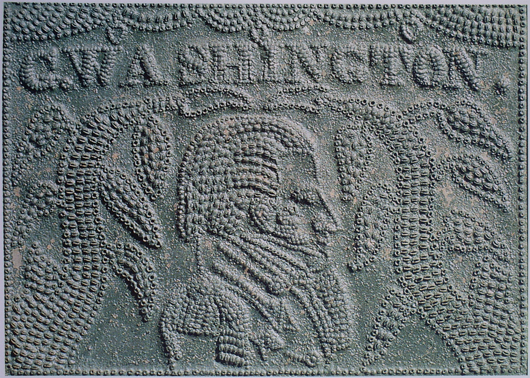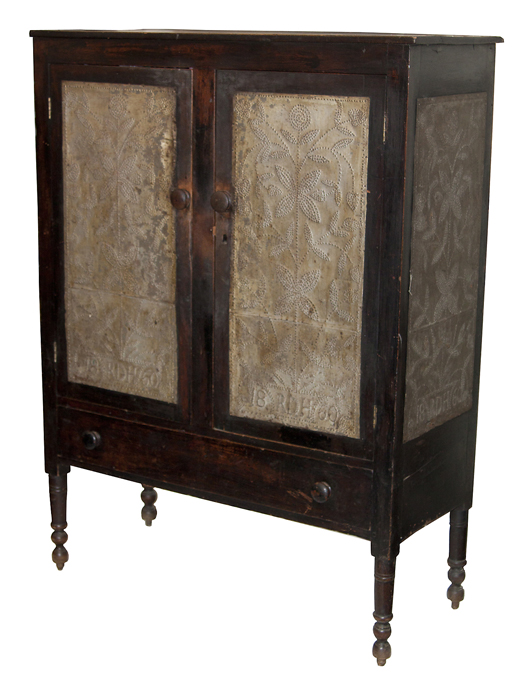
MOUNT CRAWFORD, Va. – Common to most 19th-century Shenandoah Valley households, the ubiquitous pie or food safe is the focus of a multiyear research project launched in August as the Virginia Safe Project. The initial phase of the ambitious study will target the Shenandoah Valley region beginning with Frederick County in the north and running southward to Botetourt County, as well as contiguous counties with associated manufacturing centers or concentrations of safes. Based on a combination of field research to record and photographVirginia safes and extensive documentary evidence, the project’s Shenandoah Valley survey will culminate in a 2013 exhibition at a soon to be announced Virginia museum as well as an illustrated catalog describing the findings.
The research and exhibition development is being conducted by Jeffrey S. Evans, principal with Jeffrey S. Evans and Associates in Mount Crawford, Va., and Kurt C. Russ, former director of Washington and Lee University’s Laboratory of Anthropology and independent scholar from Lexington. This partnership brings together Evans’ vast knowledge and scholarship of Shenandoah Valley decorative arts with Russ’s years of collecting and study of Virginia safes and expertise in 19th-century material culture. Notable among their prior regional studies is Evans’ acclaimed Come in and Have a Seat: Vernacular Chairs of the Shenandoah Valley 2009 exhibition and catalog for the Museum of the Shenandoah Valley and Russ’ 2005 collaboration on the Stoneware of Eastern Virginia exhibition at the Virginia Historical Society and related publications. Evans and Russ will also be engaging a comprehensive ancillary pool of decorative arts scholars, collectors, and dealers, as well as national institutions and local historical societies as consultants for the project.
The researchers request that those having pie/food safes, or other related 19th-century architectural or furniture forms displaying punched-tin panels (e.g. sideboards, slabs, cupboards, cabinets, interior doors) contact them to be included in this important study. Of particular interest are examples with documented or associated oral history suggesting a Virginia origin, especially signed and/or dated specimens, and those featuring unusual punched designs/motifs or historical surfaces. In addition, Evans and Russ are actively seeking unpublished documentary or ephemeral materials evidencing safe production and usage, as well as any vintage photographs depicting safes or related forms in a historical context.
One goal of the overall project is to produce a database of Virginia punched tin-paneled furniture that allows for comparison of elements of design and construction throughout the Old Dominion. Evans and Russ explained, “By combining documentary research of local cabinetmakers and tinsmiths with a fundamental understanding of Valley settlement and economic patterns, an emerging picture of the ‘Virginia Safe’ in the Shenandoah Valley is forthcoming. Details of the provenance of specific safes combined with careful attention to dated, signed and initialed examples, and a focus on variations in tin-design elements provides preliminary definition of area and potential schools of production.”
Initial research has already defined several such distinctive schools of Valley safe production. Two particularly exciting groups for which the researchers are eagerly seeking comparable examples emanate from the counties of Rockbridge and Shenandoah. Lexington cabinetmaker Matthew Kahle, in conjunction with local tinsmiths, produced distinctive flat-wall food safes embellished with politically oriented themes and images including the likeness of George Washington on several extant examples. Shenandoah County witnessed the production of a series of equally remarkable safes distinguished by elaborately punched, adjoined-tin panels depicting flowering plants rising from a central pot and containing the makers’ initials and often associated date. “Representing a special cooperation between craftsmen, the safe becomes an important artifact of 19th-century Shenandoah Valley material culture particularly expressive (in combining furniture elements and tin design motifs) and well-suited to questions regarding the makers’ and consumers’ shared cultural heritage and the evolution of traditional foodways in the Shenandoah Valley,” said Kurt Russ, co-director of the project.
A web page describing the project (www.TheVirginiaSafeProject.com) and a blog allowing for public comment, recordation of family-owned safes and project participation is being developed. In the interim, the researchers encourage and welcome the involvement of those with information about Virginia safes and other punched tin-paneled furniture, or those having examples they would like documented as a part of the study.
Complete confidentiality and discretion is assured.
Contact Information:
Kurt C. Russ: kcruss@comcast.net; 540-958-8534; 203 S. Main St., Lexington, VA 24450.
Jeffrey S. Evans: jeff@jeffreysevans.com; 540-434-3939; 2177 Green Valley Lane, Mount Crawford, VA 22841.
ADDITIONAL IMAGES OF NOTE




